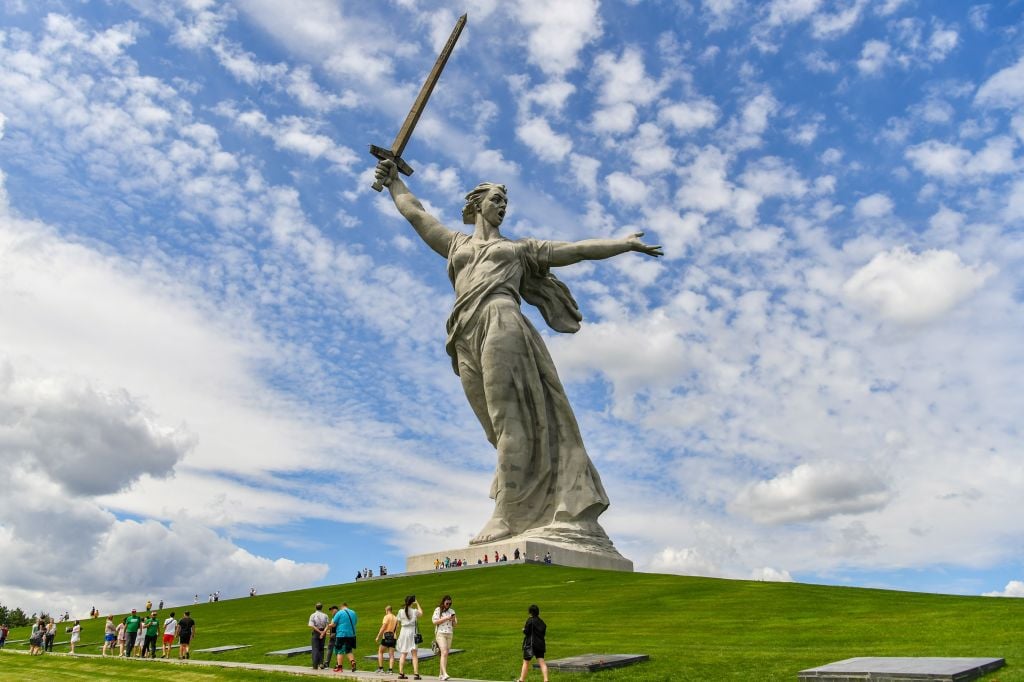
The Soviet Union knows no shortage of mind-bogglingly enormous and (therefore) unrealized construction projects. Tatlin’s Tower, also called the Monument to the Third International, which was supposed to have been the St. Petersburg headquarters of the Communist International, would have been over 1,300 feet tall, dwarfing its source of inspiration: Paris’s Eiffel Tower.
Then there’s the Palace of the Soviets, a 1,365 foot tall political convention center in Moscow that would have been built on a plot of land formerly occupied by the Cathedral of Christ the Savior. With a main hall planned to seat 20,000 people, the palace’s total volume would have surpassed that of the six tallest skyscrapers in the United States.
Alas, financial and architectural constraints prevented many of these grand designs from being realized. One record-breaking architectural that did see the light of day is The Motherland Calls!, a 172-foot-tall statue of a woman raising a sword (279 feet if you include the sword itself) located in Volgograd. Formerly known as Stalingrad, after Joseph Stalin, this city was the site of one of the longest, biggest, and most important battles of the Second World War.
As its self-explanatory name suggests, the female figure of The Motherland Calls! symbolizes Mother Russia, calling on her citizens to join the war effort and follow her to victory. At the time of its completion in 1967, it was the tallest statue on Earth—a title that has since passed to a series of increasingly gargantuan religious and political statues in East Asia.
The Motherland Calls! at the Mamayev Kurgan World War Two Memorial complex in Russia’s southern city of Volgograd. Photo: Kirill Kudryavtsev / AFP.
The Motherland Calls! was designed by Yevgeny Viktorovich Vuchetich, a sculptor born in Ekaterinoslav, in modern-day Ukraine. He was a leading figure in Soviet realism, an artistic movement that rejected the futuristic experimentation of early 20th-century artists like Kazimir Malevich in favor of more representative and allegorical representations of Soviet ideals. He was also a fivefold recipient of the Stalin Prize, and designed numerous monuments dedicated to the USSR’s heroes.
The unfathomable scale of The Motherland Calls!, which is twice as tall as New York’s Statue of Liberty and 40 times as heavy, made for a laborious construction process. Vuchetich allegedly required more than 5,5000 tons of concrete and 2,500 metric tons of metal, which had to be assembled with the help of structural engineers. Any structure of this size threatens to collapse under its own weight, and the statue’s elegant pose—stepping forward, arms widespread and raised—made this threat even greater.
The Motherland Calls in Volgograd, Russia, 2018. Photo: Claudia Thaler / picture alliance via Getty Images.
There are multiple explanations for why The Motherland Calls! had to be as big as it is. For one, its size is meant to represent the scale of sacrifices the Russian people were forced to make during the war. Another, arguably more useful explanation has to do with geopolitics. The statue was, after all, completed in the middle of the Cold War, a time when the USSR competed with the U.S. in many different contests, from sending people into space to building the world’s tallest structures.
But size comes at a cost. Over time, the statue has been renovated on several occasions. One of the first took place in the early 1970s, when engineers reinforced the statue’s sword to prevent it from swaying in the wind and potentially breaking off. The most recent restoration began in 2019, after a report showed that the statue’s foundation was sliding away as it had been built on top of a riverbed.
Decades after its construction, The Motherland Calls! remains one of the most popular tourist destinations in Russia. It’s a point of pride for its people, symbolizing what their country can collectively achieve in spite of past or present hardships. Even if it’s no longer the world’s tallest statue—India’s Statue of Unity is almost twice as big—it’s still one of the most impressive statues in the world.
Sometimes, archaeology gets big. In Huge! we delve deep into the world’s largest, towering, most epic monuments. Who built them? How did they get there? Why so big?